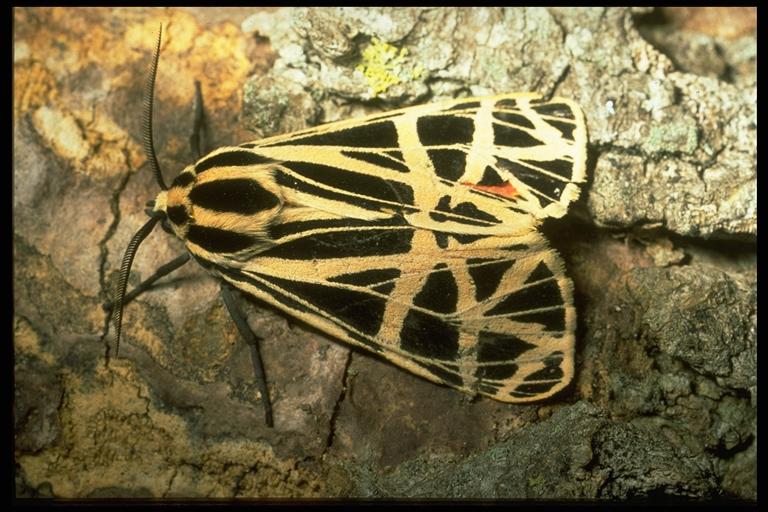
Virgin tiger moth, Grammia virgo Linnaeus (Lepidoptera: Arctiidae), adult. Photo by Drees.
Common Name: Virgin tiger moth
Scientific Name: Grammia virgo Linnaeus
Order: Lepidoptera
Description: The saltmarsh caterpillar, Estigmene acrea (Drury), grows to 2 inches, has bunches of short bristles and longer, whitish hairs covering its yellow to dark brown body. It curls up when disturbed. Adult moths (2 inch wingspan) are overall white, with the forewings having some small black spots and the abdomen yellow with black spots. The woolybear caterpillar, Pyrrharctia isabella (Abbot & Smith), caterpillars grow to 2. 1/4 inches, and are red-brown with black at both ends of the spine-covered body. The adult stage, called the Isabella tiger moth, has a 2 inch wingspan, and is overall yellow-brown with the abdomen marked with black spots.
There are a number of other common arctiid moths that occur at lights. Two of the more colorful are: the virgin tiger moth, Grammia virgo (Linnaeus), with a 3 inch wingspan, has cream-colored forewings with black patterns. The hind wings are orange with black patches; and the giant leopard moth, Ecpantheria scribonia (Stoll), with a 3 inch wingspan, is white with black open-circular spots on the forewings and a metallic blue abdomen with orange markings. Caterpillars of this species grow to 3 inches long, are black with red bands between the body segments and clusters of short stiff spines. Host plants include weeds and some landscape plants. Overwinters as a larva.
Life Cycle: Both species overwinter as larvae. Caterpillars of the woolybear caterpillars in the fall are thought to indicate the severity of the oncoming winter by the proportion of red-brown to black on the body, although this is good folk lore, there is apparently no scientific evidence supporting this idea. Adults occur in the spring.
Habitat and Food Source(s): Caterpillars have chewing mouthparts. Adults have siphoning mouths. Saltmarsh caterpillars are general feeders, eating leaves of weeds and grasses. Partially-grown caterpillars often migrate into row crops such as soybean fields, gardens and landscapes. Woolybear caterpillars feed on leaves of weeds and grasses.
Pest Status: Caterpillars feed on leaves and may cause a problem when occurring in high numbers on landscape plants or crops. Contact with their hairy bodies can cause irritation to the skin. Moths are common near lights.
For additional information, contact your local Texas A&M AgriLife Extension Service agent or search for other state Extension offices.
Literature: Wright 1993.